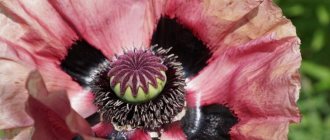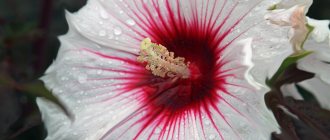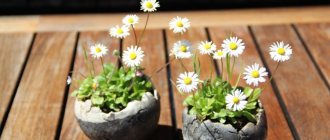Home » Flowers and plants » Indoor plants
Vladimir 03/16/2020
20018 Views
If you are a lover of indoor plants, then the campanula flower, popularly called “the bride and groom,” will not leave you indifferent. When I first came across this plant, I was simply fascinated.
Introduction
How did I first become acquainted with the beautiful flower “Bride and Groom”? My passion is growing indoor plants. They decorate the house with unusually bright flowers and variegated leaves. Watching how green pets develop is very interesting. In the spring, a friend gave me a small cutting of a plant and said that it was called “bride and groom”.
People gave a flower called campanula the romantic name “bride and groom”
I put it in water and a few weeks later, when roots appeared, I planted it in a pot. I used a soil mixture of greenhouse and leaf soil, peat and sand. The cutting took root easily and began to grow.
I placed the container with the plant in a deep tray and poured settled water into it every morning so that the plant did not lack moisture. Once every two weeks I watered it with special fertilizers for beautifully flowering indoor plants.
I pinched the quickly growing side shoots, and soon the bush became very branched and lush, numerous buds appeared on it, which bloomed one after another.
Composition of campanula and coleus
And somehow the plant became covered with the most delicate flowers. The bride and groom plant looked great on the window. In the summer I put it on the balcony, where she felt especially good.
After a long flowering at the end of summer, the campanula dropped its leaves, the shoots stretched out, I carefully cut them off and put the container in a cool place. With the onset of spring, I began to water the plants again and placed it on the windowsill. Soon new shoots appeared and already in mid-May the “bride and groom” pleased with their flowering again.
Indoor campanula in the interior and not only
Bells in indoor culture are not as simple plants as they might seem at first glance. Of course, they remain a luxurious, eye-catching decoration for rooms, but their scope of use is much wider. After all, campanulas are perfect for the role of:
- a spot of color, a bright and catchy accent that emphasizes the palette of the interior;
- a beautifully blooming accent that attracts the eye;
- decorating empty, boring corners that lack thoughtful design and stylish details;
- accent in nostalgic and romantic interiors;
- decoration of balconies and terraces.
It is advisable to display Campanula as a soloist, away from other indoor plants (except for compact decorative foliage crops). She is especially good as a single accent. And the “cleaner” the background for it is, the better. Avoid additional decor, elaborate containers, or an abundance of details - the campanula needs a simple and modest presentation.
Description
Hybrid with lilac flowers
Campanula is a well-known indoor plant that belongs to the bellflower family. It can be found in the wild in many countries of Southern Europe.
A significant number of species of this plant have been cultivated and are now actively used as indoor plants.
- Campanula can be either annual or perennial.
- Plants are varied in shape, flower color, size, and there are hybrid double forms.
- Campanula equifolia is cultivated as an indoor crop. This plant is perennial, with thin shoots, sometimes creeping, in rare cases hanging down up to 25 cm long.
- The arrangement of the leaves is alternate; the leaf blades are attached to the stems with the help of elongated petioles.
- The leaf shape is heart-shaped or oval with small teeth. The leaves range in color from light green to dark green.
- The flowers are collected in inflorescences of several pieces; after flowering, a small fruit appears in the form of a box.
- Among indoor flower lovers, the most common hybrid is “Alba” (with white flowers) and “Maya” (with blue or purple flowers). People call them “the bride and groom.”
Hybrid "Alba"
All representatives of the bellflower family are not very demanding; they need the most basic things - watering, moderate lighting, and periodic feeding.
General information
DESCRIPTION
The Bride and Groom are distinguished by their special characteristics: shape, color, size of flowers. The plant is a hybrid terry plant with creeping thin shoots that can hang down up to 25 cm. The leaves are arranged alternately and have a heart-shaped round shape. The color of the leaves varies from light green to dark green. There are also varieties with purple and pink flowers. The petioles are long with leaf blades on the stems. The inflorescences include two to four bell-shaped flowers. The flowers consist of 5 petals, 4 cm in diameter.
Interesting fact! The Bride and Groom flower is considered the best gift for newlyweds. According to the sign, he can help create a strong family, fill life with happiness, improve the energy at home and relieve stressful situations.
BLOOM
Flowering lasts from early May to late summer. Flowering of a young plant will occur 1.5 years after planting under the necessary conditions. After flowering, a small fruit, similar to a box, remains on the plant. Next, the plant needs rest. In order for new buds to appear, you need to cut off dried shoots and flowers from the plant before resting. Pruning is done in late autumn-early winter (October-December), leaving only 2-3 buds. The stems are shortened by 12 cm. In the spring, they are pruned again, leaving 5 cm of their own length. Dormant buds will wake up and new, strong shoots will develop from them.
Flowering ends approximately 3 years after planting, when lignification of the shoots occurs. One of the options for rejuvenation is cuttings at the end of February.
REST STATE
The dormant state occurs after the end of the growing season, in late summer - early autumn. At this time, you need to cut off elongated shoots, place the pot in a cool place, and limit watering to 1-2 times a month. With the onset of spring days, the flower comes to life, wakes up, it puts out new shoots, and it is transferred to a warm place.
Lighting
This plant does not require lighting. It is not recommended to grow on southern and northern windows. When grown on windowsills facing south, it is recommended to protect plants from bright sunlight by creating shading.
It is desirable that the light be bright, but diffused
If you grow campanula on a north window, there is a risk of the shoots stretching. In such plants, the distance between the leaves increases, and the decorative appearance of the plant suffers from this.
Plants love a lot of light, but are afraid of direct, burning sunlight, especially on hot summer days. Provide them with partial shade.
Temperature
Thermometer for monitoring room temperature
In spring and summer, the most optimal temperature is 23 – 26°C; in winter, it is better to keep plants at a lower temperature from plus 12 to plus 14°C.
In winter, do not leave the plant on the windowsill under which the heating radiator is located; it is better to move it to a cool place, but keep in mind that the lower limit is +12°C. Do not be afraid of temperature changes, as these plants tolerate them quite well.
Campanula has the ability to adapt to different temperatures, and thanks to this property, a flowering plant can be transferred from the room to the balcony, back and forth, without fear of any negative consequences.
Bluebell care
Caring for Campanula at home is based on following a few simple rules.
Location, lighting, temperature
The best place for a flower is a lighted windowsill, protected from direct sunlight; you should choose windows facing west and east.
In winter, artificial lighting is useful. The bell reaches for the light source.
To keep the plant looking neat, it is recommended to rotate it in one direction (clockwise or counterclockwise) every week. The plant does not tolerate a 180° rotation. It is better to choose places with uniform lighting.
The air temperature in the warm season should be within +17...+22 °C; Campanula tolerates wintering at +5...+10 °C.
High temperatures negatively affect the health of the plant - it begins to dry out.
Planting, choosing pots, soil
The soil for planting is prepared from leaf and turf soil, sand and peat. The composition is a variant of loose, breathable and slightly alkaline soil. If necessary, the substrate for planting can be purchased at the store.
Watering and humidity
Campanula loves water
As for watering, its scheme is classic: abundant in summer, moderate in winter.
1Spraying is recommended, especially in dry weather, and in summer during heat.
2Do not allow the soil to become excessively waterlogged. To avoid water stagnation, use drainage in the form of expanded clay balls.
3 In autumn and winter, limit watering to a minimum.
4In spring and summer, these plants need to be fed with complex fertilizers every 3 weeks.
5The best watering is from below.
Note to the florist
Why doesn't Campanula bloom?
- Perhaps your plant is already old, its life cycle is ending. It is necessary to renew the flower by planting new cuttings in the pot in the spring.
- The reason for insufficient flowering may be a lack of light. Just move your campanula to a sunnier place. In summer, bells feel good in the fresh air - on the balcony or in the garden.
- A lack of microelements can also cause a lack of flowers. After all, a plant needs a lot of strength to bloom. Feed the plant once every two to three weeks with complex fertilizers for flowers. Just don’t overdo it; in this case, more does not mean “better.” To feed campanula, you can use complex fertilizer for flowering plants “Etisso” or “Kemira-Lux”.
Why does campanula wither?
- First of all, you should adjust the watering regime. Campanula does not like drought, but also does not tolerate excessive moisture and stagnation of water.
If you notice that the plant has become lethargic, and the soil is too wet and has an unpleasant odor, the root system may be damaged. The plant must be transplanted into a new pot, removing all rotten parts of the rhizome.
- If the light is too bright, campanula flowers quickly fade and wither. Shade your plant a little.
Fertilizers
The use of complex fertilizers will allow you to obtain flowers with bright colors
Use mineral and organic fertilizers 2 - 3 times every thirty days (spring and summer). Water once every two weeks with special fertilizers for beautifully flowering indoor plants.
Signs and superstitions
Campanula - from Latin - bell, the name is ancient, shrouded in secrets, legends, and popular beliefs.
According to legend, back in the 16th century. Bishop Paulinius in the province of Campania was so amazed by the beauty of this flower that he ordered the first church bell to be cast from copper in the image and likeness.
In Rus', this plant was affectionately called bells, chobotki, or little bawlers. According to popular belief, the flower had magical powers; its ringing could only be heard on the night of Ivan Kupala.
Ancient Slavic pagans attributed to the bell and other meadow flowers the ability to lead round dances at night, from which even the stars began to blink in surprise.
The girls used the magic flower as a love potion.
It was also believed that the miracle flower should be placed in shoes, and then it would definitely bring good luck.
According to the Celtic Druid horoscope, bell people born in June have an extraordinary mind, are reliable and lucky.
Growing this flower at home, according to signs, means ensuring a prosperous, happy life, full of harmony and love.
On the wedding day, according to legend, the bride and groom should be given a campanula with snow-white and blue flowers - a symbol of family happiness, fidelity and love.
On the site you can find equally interesting articles about indoor plants, for example: cissus, dichondra and stephanotis.
In conclusion, it should be noted that campanula will decorate any flower garden and make the interior of every home cozy. You just need to take into account the characteristics and preferences of a particular variety and know how to properly care for this plant.
>
- Author: Maria Sukhorukikh
Rate this article:
- 5
- 4
- 3
- 2
- 1
(0 votes, average: 0 out of 5)
Share with your friends!
Transfer
At the end of summer, the growing season of the plant stops, and it requires preparation to enter a state of dormancy. The most acceptable method of propagation is vegetative : by cuttings, green shoots, by dividing the bush into several parts.
Plants need to be replanted more often. Most ornamental plants like to be replanted fairly frequently.
Repotting indoor plants
The fact is that when grown for a long time, no matter how beautiful the plant is, it loses its decorative effect over time, the shoots lengthen, and the distance between the leaves increases. It no longer looks so chic and fluffy, as if it is “balding”.
To avoid this, take cuttings and form new bushes from the resulting cuttings. After a long flowering at the end of summer, Campanella sheds its leaves, the shoots become elongated, and the decorative effect decreases.
Reproduction
If the plant has grown enough and does not fit into the volume of the container, it must be divided into several parts. Carefully remove the bush from the pot with a lump of earth. Using a sharp knife, the rhizome is cut into pieces.
Don’t forget to treat the cut areas with crushed wood charcoal. Plant the resulting parts in new containers of smaller volume. It is not recommended to immerse plants deep into the soil. Immediately after transplanting, provide the plant with plenty of water and shade.
Using cuttings
Campanula cuttings
- Cuttings are very easy to obtain. When pruning elongated shoots, use the lower parts for rooting.
- Rooting occurs best in a mixture of peat and sand.
- For cuttings, it is necessary to provide greenhouse conditions; it is advisable to cover the plant with a polyethylene cap and regularly spray it with water from a spray bottle.
- The optimal rooting temperature is 20 – 24°C.
- After the shoots grow to 7 - 10 centimeters, pinch their tops. This procedure provokes the appearance of additional shoots. Your bushes will be more branched.
Cuttings can be resorted to in the summer. They will grow over the summer and autumn, but by the beginning of winter the green part needs to be cut off and the flower allowed to rest. Already in the first spring after transplantation, campanula can bloom with proper care and timely feeding.
Green shoots
This type of vegetative propagation should be resorted to in the spring, when young green branches grow at the campanula. They can be cut and rooted.
How to do it correctly:
1Separate the green shoot from the “heel”
2Plant it in a mixture of loose peat soil and sand
3Cover with plastic wrap
4Ensure greenhouse conditions
5Keep the container with young shoots in a cool place at a temperature of plus 12-15 degrees
6Don’t forget to spray and ventilate your miniature greenhouse every day
Mini greenhouse for rooting cuttings
Campanella takes root quite quickly; after two weeks, small roots form. After the plants begin to actively grow vegetative mass, move them to a brighter and warmer place.
When the plant reaches a height of ten centimeters, it is necessary to pinch it so that it begins to branch and bush.
Propagation by seeds
The seeds of this plant are very small; they need to be planted superficially in small bowls filled with soil mixture. It is advisable to cover the seeds with a thin layer of soil on top. For seeds during the germination period, it is necessary to provide a greenhouse effect, wrap the top with plastic film or glass.
Sprouted seeds
Be sure to provide periodic ventilation to prevent excess condensation from accumulating. After the third leaf appears, pick up the seedlings, do not forget to pinch, this will allow you to get a branchy bush. Plants grown from seeds usually bloom in the second year.
Planting and care
Despite its fragility and tenderness, this plant as a whole can be called unpretentious. Having learned the basic requirements of campanula for growing, it can be enjoyed by an amateur and an experienced gardener.
Where to plant
This plant is light-loving, so it should be placed in sunny areas of the garden with light shade. At midday, direct rays of the sun will harm foliage and delicate flowers. If the plant is grown in a pot, then in hot weather it is better to put it in a shaded place.
If Campanula is planted indoors, it is recommended to place it on windows of east or west orientation. If the plant is deprived of the proper amount of light, it will become pale and frail. If necessary, in room conditions, additional illumination from artificial light sources will be provided.
If the recommended lighting conditions are met, then you can place the pot with campanula on the balcony for the entire summer season. At the end of September, when the nights become cooler, the flower is returned to its original place indoors.
This plant has problems with temperature fluctuations. In summer, campanula feels great at temperatures of +20....+25C, and in winter it can grow normally at temperatures of +15C. During winter maintenance, the flower container with the plant should be removed away from heating devices, which are a source of dry air.
Although it is worth recognizing that air humidity is not particularly important for this plant. If the air in the room is excessively dry, it is recommended to spray the bush.
Watering
Campanula should be watered as the soil dries. This wonderful representative of the flora is suitable for those owners who are away for several days and cannot water their plants. There is evidence that campanula can live for several weeks without moisture. But loving gardeners will not unnecessarily subject their plants to such tests.
In hot weather, the soil in the container dries out very quickly, so it is necessary to water the plant much more often. Water is used that is warm and preferably settled. Tap water is not suitable for irrigation.
The soil
The soil for campanula requires loose, nutritious soil. The plant must be nourished by microelements contained in the soil. An excellent soil option is a mixture of peat and leaf soil. Feed the bushes twice every 30 days. Universal mineral compositions are suitable for these purposes. In winter, when the plant is dormant, it does not need fertilizer.
Planting and transplanting
Not all types of Campanula are perennial, so annual replanting is not always necessary.
It often happens that a plant grows excessively in one container or in a garden bed. And then it makes sense to transplant the campanula.
When transplanting a flower into a container, a drainage layer is poured onto the bottom, after which it is covered with nutritious soil. The plant is placed in a hole and covered with soil mixture. After soil compaction, watering is carried out. If in the autumn a bush is transplanted from a garden bed into a flower pot to move the plant into a room, then they try to remove the root system with a lump of earth.
Diseases and harmful insects
At home, plants are much less susceptible to diseases and pests. However, they are not 100% protected. If not properly cared for, a number of problems can arise.
Gray rot
With constant waterlogging of the soil, when there is no drainage in the flower pot, the water stagnates, which in turn leads to acidification of the soil.
Gray rot thrives in damp soil. When affected by gray rot, plants wither and the root system begins to rot.
An unpleasant odor appears in the room where the flower affected by gray rot is located. Sometimes, when the rotting goes very far, the flower can no longer be saved.
In any case, first of all, you need to cut off the rotten twigs and leaves and throw away the old soil. Transplant the flower into new light soil, reduce watering.
Fusarium
If temperature conditions are not observed, as well as in the absence of light, the viability of the plant decreases. Sometimes fusarium can be observed on the “bride and groom” flower; it is accompanied by yellowing of the tips of the leaf blades.
In severe forms, the leaves die and the shoots wither from the root.
Heart rot
If you find brown heart-shaped spots with a gray coating on the leaves, then it is likely that the plant has developed brown heart-shaped rot. This disease is caused by pathogenic microscopic fungi.
To combat them, fungicides are used, while watering is reduced and the plants are regularly ventilated.
Spider mites, aphids, scale insects
If the plant is in a dry room, aphids or scale insects may appear. At the first symptoms of these diseases, treat the plants with insecticide preparations. A proven folk remedy against aphids and scale insects is a soap solution.
Spider mites are the scourge of many indoor plants. Use broad-spectrum insecticides to combat it.
An effective drug against aphids
Most often, the companula is affected by aphids
Most often, companula is affected by aphids. Aphids multiply very quickly, so control should begin when they first appear. It is better to use systemic preparations that not only destroy the pest during treatment, but also continue to act for some time in the plants themselves.
There is a drug "Biotlin" designed to protect against sucking pests.
The treatment solution is prepared at the rate of 0.5 ml of the drug per 1 liter of water. Penetrating into the plant within a few hours, the drug will protect it for at least two weeks.
Diseases and pests
- When the root system of a flower remains in wet soil for a long time, the rhizome may begin to rot. In addition, rot may form on the shoots and leaves due to non-compliance with the watering regime.
- Scale insects or spider mites often settle on campanula. To see these pests, you need to inspect the flower more often. Scale insects can be detected by enlarged areas on the shoots.
- And because of the mites, the leaves will be covered with a thin web and become slightly sticky. First, you can try to get rid of it with soapy water. If washing with water does not help, then resort to spraying with insecticides.
- When a flower pot is placed in the wrong place, the leaves may turn yellow. It is also necessary to protect the plant from the rays of the sun. Choose the right place and such problems will not arise.
- The already thin shoots begin to stretch out with a clear lack of lighting. You need to move the flower to a more illuminated place. If watering is excessive, the leaves will become lethargic and lose turgor. After stabilization, the foliage returns to normal.
Varieties
Terry hybrids
Terry hybrids
Terry hybrids Recently, the most beautiful hybrids of terry campanula have appeared. The terry hybrid was bred by crossing the Carpathian bellflower and Campanula sparrowfolia.
Terry companula looks like a small bush dotted with large double flowers. The stems are shortened, the leaves are densely arranged.
It should be remembered that double forms of flowers, as a rule, are more finicky and do not take root with all amateur gardeners.
Carpathian campanula
Carpathian Campanula in natural conditions
Carpathian Campanula This plant can grow both in open ground and indoors. This is a herbaceous plant that resembles a bush.
Its height can reach 30 cm. The leaves are located below in the form of a basal rosette; they are oval in shape.
The flowers are quite large, up to 6 cm in diameter, and come in white, blue, lilac and violet colors. Under natural conditions, this plant is found in the Carpathian mountains.
It blooms from May to August.
Campanula flowering
Campanula is especially decorative during flowering. The flowers of the plant are shaped like bells, hence the name of the plant - “Campana” means “bell”.
The flowers of the plant are most often blue or white, collected at the ends of the shoots. With proper care, flowering is abundant and long-lasting - campanula blooms all summer.
A special feature of caring for campanula during flowering is the removal of faded dry inflorescences and leaves. Maintaining plant “hygiene” will increase the duration and intensity of flowering.











